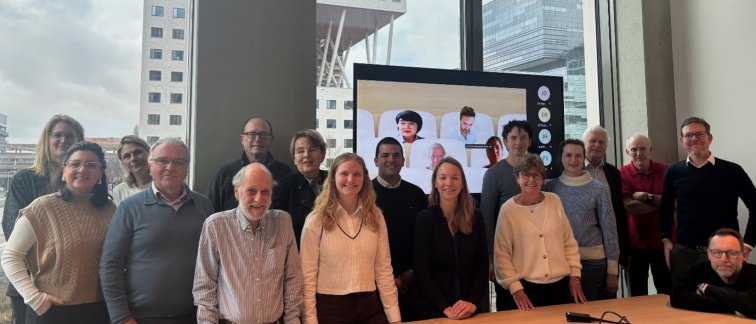On Monday January 27 2025, the first AR&D Lunch talk meeting of the year took place at the brand new Research Building of the Vrije Universiteit Amsterdam. The meeting was hosted by AR&D researchers Dr. Jenny van Dongen, PhD student Nikki Hubers and prof. Dorret Boomsma. This lunch talk kicked-off the international Twinning Genetics Consortium Meeting, which took place in Amsterdam the last week of January. The meeting aimed to share new knowledge about twinning and fertility, and to facilitate exchange of knowledge and ideas between researchers. The meeting was attended by researchers from the Vrije Universiteit and Amsterdam UMC, including AR&D researchers and students from the research master genes in behaviour and health.
 First AR&D lunch talk of 2025 at the VU Research Building
First AR&D lunch talk of 2025 at the VU Research Building
Prof. Nils Lambalk opened the lunch meeting, explaining to the audience the importance of research into the connections between fertility and twining. Next, the first international guest speaker, Prof. Claudio Stern (University College London, Department of Cell & Developmental Biology, UK) shared exciting novel genetic findings from his research on monozygotic twinning in large human pedigrees from Brazil and India. Prof. Stern also presented latest insights from molecular studies in animal models of monozygotic twinning. After this, Dr. Jenny van Dongen presented latest findings from her research for which she and colleagues received the AR&D Research Grant, on DNA methylation in monozygotic twins and patients with Amoplasia, a rare congenital disorder with a 10-fold higher frequency of monozygotic twins among patients. The next international guest speaker Prof. Nick Martin (QIMR Berghofer Brisbane, dept. Genetic Epidemiology, Australia), provided an impressive overview of decades of research on the genetics of dizygotic twinning. In the last talk of the symposium, entitled “What genetic research can tell us about the relation between DZ twinning and female fertility”, AR&D PhD student Nikki Hubers shared the latest results from her studies on the genetics of dizygotic twinning. She showed the strong negative correlation between genetic risk of anovulatory fertility and dizygotic twinning, and presented a polygenic score that is predictive of the chance of women to give birth to dizygotic twins after natural conception, and which is lower in women who give birth to dizygotic twins after ART (Assisted Reproductive Technology).
 Guest speaker prof. Claudio Stern
Guest speaker prof. Claudio Stern
 Guest speaker prof. Nick Martin
Guest speaker prof. Nick Martin
 PhD student Nikki Hubers, explaining how the polygenic score of dizygotic twinning is constructed
PhD student Nikki Hubers, explaining how the polygenic score of dizygotic twinning is constructed
In between presentations, participants and speakers continued discussions while enjoying a nice lunch with delicious sandwiches, wraps and fruit. We look back at an inspiring meeting, where new connections were establihsed and research ideas were discussed.
Thank you to AR&D for the opportunity to organize this event, and to the many AR&D colleagues for attending and sharing their insights and perspective on the topic of twinning and fertility.

